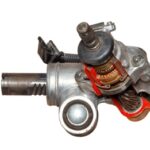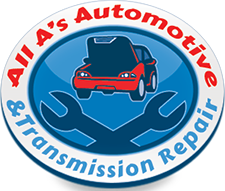How Does My Car’s Power Steering System Work?

 Do you ever feel like you have to arm wrestle with your car’s steering wheel to get it to move in the direction you want? Well, my friend, I have some information you might find helpful. Most cars built within your lifetime have a form of power-assisted steering to help reduce the force and strength required to steer it. In fact, the power steering system works so well that when a bad pump or low fluid occurs, you may find moving the steering wheel next to impossible.
Do you ever feel like you have to arm wrestle with your car’s steering wheel to get it to move in the direction you want? Well, my friend, I have some information you might find helpful. Most cars built within your lifetime have a form of power-assisted steering to help reduce the force and strength required to steer it. In fact, the power steering system works so well that when a bad pump or low fluid occurs, you may find moving the steering wheel next to impossible.
How Power Steering Works
Power steering utilizes technology to reduce the physical effort necessary to turn the steering wheel – especially at slower speeds. There are three types of power steering systems: hydraulic, electric, and a hybrid of the two.
Hydraulic Power Steering
This type uses hydraulic fluid and a pump to assist the driver with steering. When you move the steering wheel, the power steering pump pressurizes the fluid, making it easier to turn the wheels. This system is widely used in older cars and some newer ones, offering a more traditional and responsive feel.
Electric Power Steering
This type is common in modern vehicles. They use an electric motor to assist drivers, making it more energy-efficient and flexible. Electric power steering adjusts its assistance level based on driving conditions, providing a smoother driving experience.
Hybrid Electro-Hydraulic
Electro-hydraulic power steering (EHPS) is a hybrid system that provides the smooth feel of a conventional hydraulic power steering assist. However, it uses electricity to create pressure instead of drawing power from the vehicle’s engine. This system also improves fuel economy since the electric-powered pump only operates when a steering assist is needed.
The Power Steering System Components
The steering system contains several crucial components, each with a unique role in ensuring smooth and precise control of your vehicle. Think of it like a skeleton, with each part connecting to the next, enabling them to convey the motion of the steering wheel to the tires.
Steering Wheel
Let’s start at the beginning. The steering wheel is your connection to the system. A domino effect applies the necessary force to steer the vehicle when a driver initiates the steering motion.
Steering Column
Next comes the steering column, which is a shaft linking the steering wheel to the steering box (rack and pinion or recirculating ball).
Steering Box
The steering box translates the input from the steering wheel into movement at the road surface through the wheels and tires. There are two main kinds of steering boxes commonly found in vehicles today: the rack and pinion and recirculating ball system.
Rack and Pinion
The rack and pinion type is typical in most modern vehicles because it is efficient and compact. It consists of a steering column connected to a horizontal rod (the rack) that moves left or right. The rack engages with a pinion gear. As the steering wheel turns right and left, the rack moves the car’s wheels accordingly. It’s a responsive system that offers direct steering control.
Recirculating Ball
The recirculating ball system was standard in older vehicles. It uses a worm gear and recirculating ball bearings to transfer the steering wheel movement to direct the wheel position. The recirculating ball system is known for durability and handling of heavy loads, making it suitable for full-size trucks and other large vehicles.
Power Steering Pump
The power steering pump pressurizes the hydraulic fluid in the steering system. This pressurized fluid assists the driver in turning the steering wheel more easily. A pulley and belt system usually powers the pump. Within the pump, the rotary vanes spin and move the power steering fluid through the system. The pressure produced varies, depending on how fast the engine turns.
Power Steering Fluid
Power steering fluid is a hydraulic fluid. It amplifies and transmits the power in your vehicle’s power steering system. So, simply put, it decreases the effort required to turn the steering wheel. It also keeps all the moving parts well-lubricated. It ensures the hoses, pistons, valves, and pump work as designed. Using the wrong power steering fluid can damage the internal components.
Read your owner’s manual to discover which type of power steering fluid your vehicle uses:
- Automatic Transmission Fluid (ATF)
- Synthetic Power Steering Fluid
- Non-Synthetic, Mineral Power Steering Fluid
Spotting Power Steering System Problems
Routine vehicle maintenance helps ensure your steering system operates correctly. If you notice any of the following signs, schedule an appointment to diagnose and repair it right away.
Dashboard Warning Light
Some vehicles have a specific dashboard warning light to indicate a problem within the power steering system. It looks like a glowing steering wheel next to an exclamation mark. Not all auto manufacturers equip all vehicles with this specific warning light, so read your owner’s manual to see if your car does.
Difficulty Turning The Wheel
Stiff or rough steering can make it difficult to keep your vehicle going in the correct direction. If the wheel is difficult to turn, feels heavy, or wiggles loosely, chances are good there is an issue with one or more steering system components.
Low or Leaking Power Steering Fluid
The power steering unit is a sealed system, so low fluid levels indicate a leak in the system. A leak may occur due to a loose-fitting component, a faulty gasket, or old, cracked hoses and lines. Look for puddles of pink or red fluid under the front of the driver’s side of the vehicle.
Other power steering fluid colors may indicate additional issues requiring a diagnostic appointment:
- Black: indicates burned fluid due to excessive heat build-up between the gears and other moving parts of the steering box.
- Foaming: indicates air bubbles in the power steering fluid. The presence of air means the fluid is not lubricating the gears properly.
- Milky: indicates water contamination in the fluid. The presence of water means a compromised component allows moisture to reduce the fluid’s heat absorption and friction-reducing properties.
Noises While Turning
Squealing, whining, groaning, or knocking noises are common with steering problems. They may become louder or more noticeable while turning the steering wheel.
Power Steering System Service in Midland, MI
Regularly scheduling steering system inspections can help catch problems early, saving expensive replacement costs. To keep your vehicle running smoothly on the road, give it the pampering it deserves. The skilled and experienced mechanics at All A’s Automotive will happily inspect your vehicle’s power steering system to discover if the rack and pinion need service or if low fluid or a bad pump is to blame for your stiff steering wheel.
Make A Power Steering System Appointment
Call us at (989)631-4672 or go to our website to schedule a power steering service appointment today!
Posted in: Uncategorized
Leave a Comment (0) ↓
